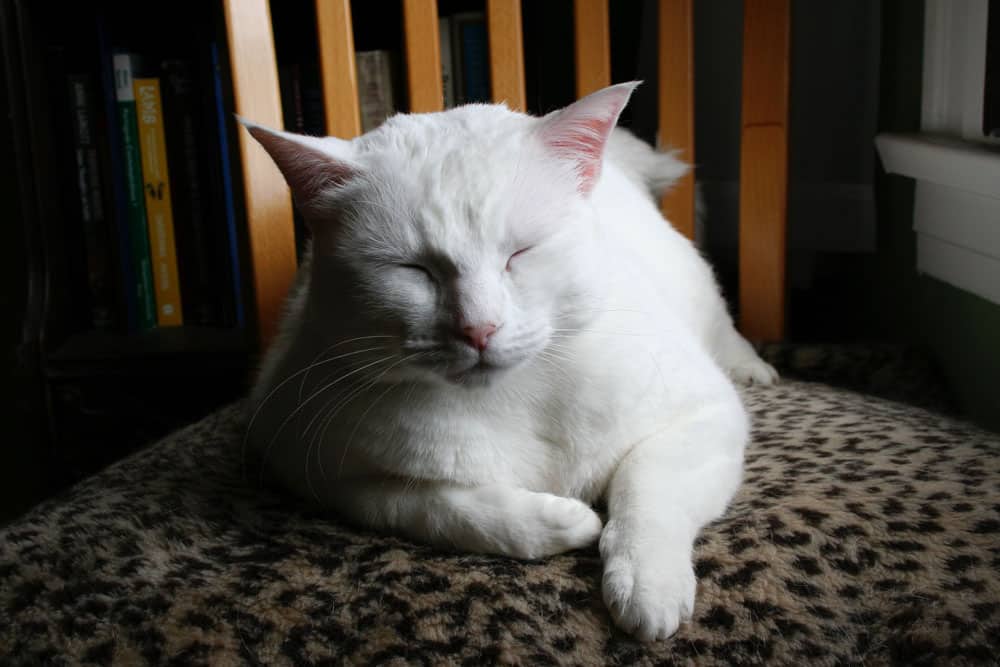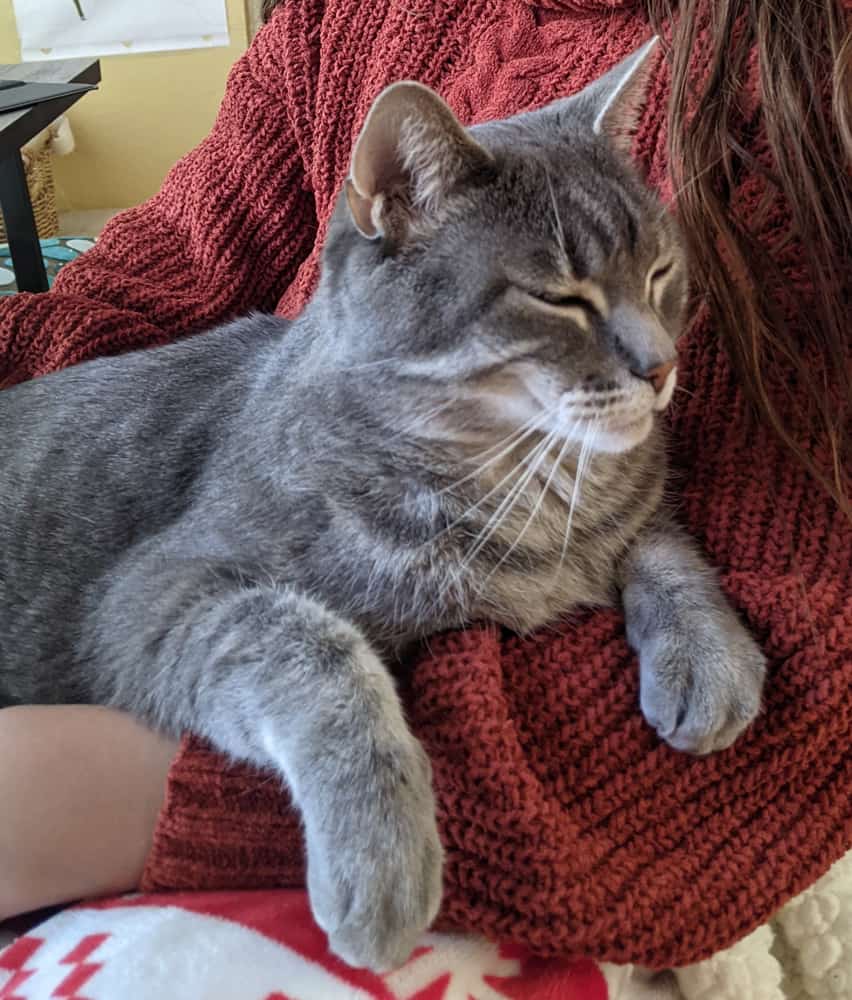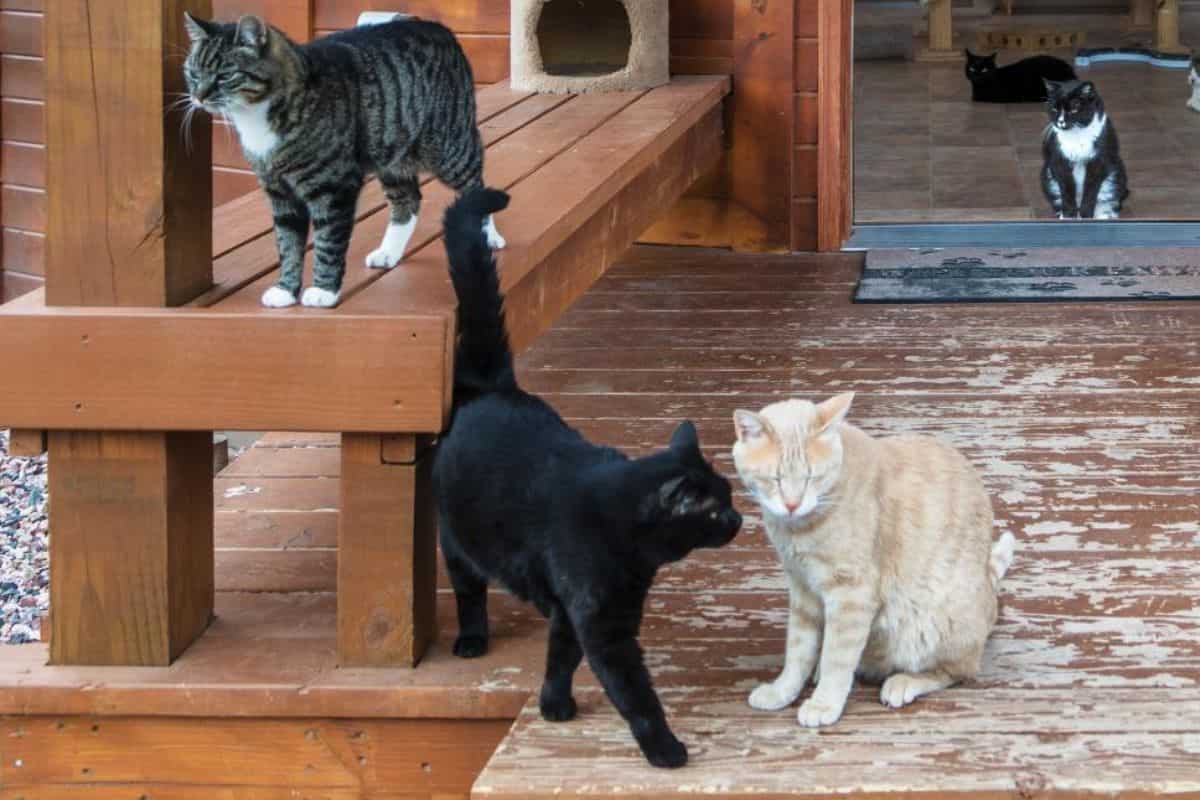For years I wanted an orange tabby, specifically a male one. I even had a name picked out for him. The cats we have ended up with have usually come our way through fate — a cat that was left with the apartment we rented, another cat showed up outside my then apartment window with a kitten in tow. None of the cats we rescued were ever orange tabbies.
Why did I want an orange tabby cat? I had always stuck fast to the reputation that orange tabbies were incredibly affectionate cats.
My daughter, when she was in the third grade, started to visit our local shelter every week to participate in their cat reading program. It was there that I met Jerry, a very small for his age, four-month old orange tabby. He had been recently pulled from a backyard along with his brother. In the shelter’s kitten room, I found him tucked inside the tunnel of a cat tree, huddled away from his littermate and the other kittens in the room.

There he was, looking all vulnerable and very unsure of his situation. I could see his brain trying to process what to do about the large face peering into the tunnel snapping a photo of him. Then, I could see him decide to go for it and he darted out of the tunnel to greet me. That little act of bravery got me hooked and I managed to convince my husband to let us adopt him.
As with introducing any new cat into an existing cat household, there were some growing pains but the new little orange tabby eventually found his footing and comfort level in his new home. Jerry, became, after multiple name changes, was eventually renamed Ori (short for Orange, of course).
True to my biased expectations of him, Ori is a highly affectionate cat. As I type out this article, he is lying between me and the keyboard, doing his very orange tabby best to convince me he is more worthy of my attention than the screen.
The loving reputation of orange tabbies has persisted over the years — vikings favored orange tabbies so much they brought them onto their ships and helped to spread ginger cats wherever they landed. This begs the question, are orange tabby cats really a super affectionate type of cat or did I just subliminally select for that personality trait at the shelter? Is there really a link between a cat’s fur color and their temperament or are these stereotypes yet another cat myth?
Common stereotypes about a cat’s fur color
- Some people believe calicos and tortoiseshells (tricolor cats) are “difficult”.
- White cats have a reputation for being aloof.
- Orange cats (also known as marmalade or ginger cats) are deemed to be very affectionate, love to eat (think Garfield), and troublemakers.
- Bicolor (typically black and white cats like tuxedo cats) are typecast as being smart.

Yet, there are plenty of anecdotes that can counter any personality stereotype of cats. There are also plenty of stories from cat owners about how distant or ornery their orange tabby cats. Years back, I was adopted by a white cat with her little kitten in tow – she was one of the most affectionate cats I ever had and would gladly come sit on the laps of my visitors and seek pets.
Some researchers believe that the reputation of white cats being aloof may be due to the higher prevalence of white cats with blue eyes being deaf — owners may be mistaking the inability of their white cat’s ability to hear and respond to them with aloofness.
What research has to say about the link between personalities and cat fur color
While the body of research about cat behavior is limited compared to dogs, there are some studies that have looked at perceptions of cat personalities and coat colors. The science on whether or not some personality trait can be assigned to a cat’s fur coat color is mostly, “eh” but there are some studies that suggest there is some weak link based on self-reported feedback from cat owners.
These studies, however, have focused on surveying pet owners and cat-to-human interactions so whether or not confirmation bias is in play by pet owners was not specifically addressed in most of them.

One study published in 2012 by a researcher from the University of California, Berkeley, surveyed 189 participants with prior experience owning cats to explore the impact of fur color on adoption rates. The survey found that respondents tended to report that orange cats were friendly, white cats were flagged as being aloof, and tortoiseshell cats as difficult. The study wanted to understand how preconceived notions linking cat fur color with personality traits affected adoption rates at shelters.
Researchers from the University of California at Davis (UC Davis) in 2016 looked at surveyed interactions among 1,274 cat owners in order to see if there was any link between cat fur color and aggression. Their study found that that “sex-linked orange female (tortoiseshells, calicos, and “torbies”), black-and-white, and gray-and-white cats to be more frequently aggressive toward humans in 3 settings: during everyday interactions, during handling, and during veterinary visits.“
Another study from 2016 by researchers from the University of Pennsylvania School of Veterinary Medicine found a link between increased aggression in tabby cats, a higher prey drive in orange tabby cats, and less aggression towards strangers by piebald (black and white) cats.
A study of 211 cat owners by researchers from the Autonomous University of Nuevo León in Mexico done in 2022 had the following results: “Gray cats had the highest score for being as shy, aloof and intolerant, while orange cats had the highest scores for being trainable, friendly and calm. Tabbies the highest for bold and active, tricolor cats for stubborn, and bicolor cats for tolerant”.
Are male cats more affectionate that female cats?
One reason orange tabbies may have earned the reputation of being highly affectionate is that several studies have found that neutered male cats are reported by pet owners to be more affectionate that female cats. Since the allele for the expression of orange tabbies found on the X chromosome about 90% of all orange tabbies are male. The orange allele is O and the non-orange is o. Female cats need O alleles on both X chromosomes to exhibit orange coats while male cats only need one O allele.
Personality is ultimately unique to each cat
At the end of the day, common wisdom is that each cat is unique. Aside from purebred cats who have been bred over generations to produce certain behavioral traits, inherent traits combine with environmental factors to affect the personalities of each cat.

What is most important is to provide your cat with a healthy and loving home. Most cats are affectionate by nature (it’s why they have become such an ingrained part of our society) and with time and respect for their needs, most cats will form a strong bond with their owners.
References
Anwar, Y. (2012, October 23). Dont be so fast to judge a cat by its color, study warns. Berkeley. https://news.berkeley.edu/2012/10/23/dont-be-so-fast-to-judge-a-cat-by-its-color-study-warns
Delgado, M.M.; Munera, J.D.; Reevy, G.M. Human perceptions of coat color as an indicator of domestic cat personality. Anthrozoös 2012, 25, 427–440. https://doi.org/10.2752/175303712X13479798785779
González-Ramírez, M. T., & Landero-Hernández, R. (2022). Cat Coat Color, Personality Traits and the Cat-Owner Relationship Scale: A Study with Cat Owners in Mexico. Animals, 12(8), 1030. https://doi.org/10.3390/ani12081030
Hart, L. A., Hart, B. L., Thigpen, A. P., Willits, N. H., Lyons, L. A., & Hundenski, S. (2018). Compatibility of cats with children in the family. Frontiers in veterinary science, 5, 278. https://doi.org/10.3389/fvets.2018.00278
Stelow, E. A., Bain, M. J., & Kass, P. H. (2016). The relationship between coat color and aggressive behaviors in the domestic cat. Journal of applied animal welfare science, 19(1), 1-15. https://doi.org/10.1080/10888705.2015.1081820
Travnik, I. D. C., Machado, D. D. S., Gonçalves, L. D. S., Ceballos, M. C., & Sant’Anna, A. C. (2020). Temperament in domestic cats: a review of proximate mechanisms, methods of assessment, its effects on human—cat relationships, and one welfare. Animals, 10(9), 1516. https://doi.org/10.3390/ani10091516
Wilhelmy, J., Serpell, J., Brown, D., & Siracusa, C. (2016). Behavioral associations with breed, coat type, and eye color in single-breed cats. Journal of Veterinary Behavior, 13, 80-87. https://doi.org/10.1016/j.jveb.2016.03.009







